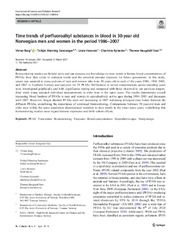Time trends of perfluoroalkyl substances in blood in 30-year old Norwegian men and women in the period 1986–2007
Permanent link
https://hdl.handle.net/10037/21842Date
2021-04-11Type
Journal articleTidsskriftartikkel
Peer reviewed
Author
Berg, Vivian; Sandanger, Torkjel M; Hanssen, Linda; Rylander, Charlotta; Nøst, Therese HaugdahlAbstract
Biomonitoring studies are helpful tools and can increase our knowledge on time trends in human blood concentrations of PFASs: how they relate to emission trends and the potential prenatal exposure for future generations. In this study, serum was sampled in cross-sections of men and women who were 30 years old in each of the years 1986, 1994, 2001, and 2007 in Northern Norway and analyzed for 23 PFASs. Differences in serum concentrations across sampling years were investigated graphically and with significance testing and compared with those observed in our previous longitudinal study using repeated individual measurements in older men in the same years. The results demonstrate overall increasing blood burdens of PFASs in men and women in reproductively active ages during 1986–2001 and decreases until 2007. However, longer chained PFASs were still increasing in 2007 indicating divergent time trends between the different PFASs, underlining the importance of continued biomonitoring. Comparisons between 30-year-old men and older men within the same population demonstrated variation in time trends in the exact same years, underlining that biomonitoring studies must regard historic exposures and birth cohort effects.
Publisher
SpringerCitation
Berg V, Sandanger TM, Hanssen L, Rylander C, Nøst TH. Time trends of perfluoroalkyl substances in blood in 30-year old Norwegian men and women in the period 1986–2007. Environmental science and pollution research international. 2021Metadata
Show full item recordCollections
Copyright 2021 The Author(s)


 English
English norsk
norsk